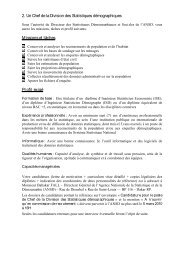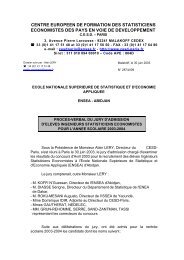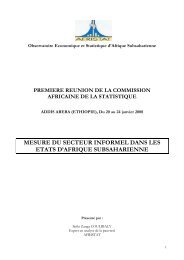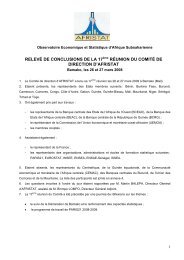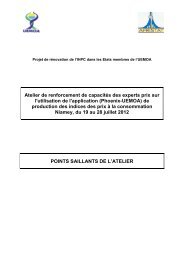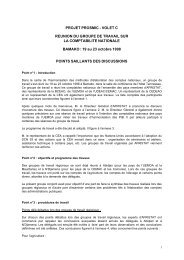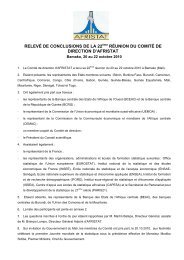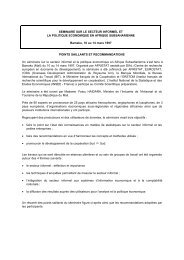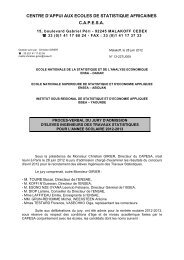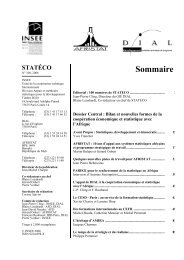Global Purchasing Power Parities and Real Expenditures - Afristat
Global Purchasing Power Parities and Real Expenditures - Afristat
Global Purchasing Power Parities and Real Expenditures - Afristat
Create successful ePaper yourself
Turn your PDF publications into a flip-book with our unique Google optimized e-Paper software.
2005 ICP: Results <strong>and</strong> Major Findings 15Figure 4 Cross-country Differences in Indexes of <strong>Real</strong><strong>Expenditures</strong> per Capita, by Product Groups(coefficient of variation)food <strong>and</strong> nonalcoholic beverageseducationhealthhousing, water, electricity, gas, <strong>and</strong> other fuelscommunicationfurnishings, household equipment, <strong>and</strong> maintenanceclothing <strong>and</strong> footweartransportconstructionmiscellaneous goods <strong>and</strong> servicesalcoholic beverages, tobacco, <strong>and</strong> narcoticsmachinery <strong>and</strong> equipmentrecreation <strong>and</strong> culturerestaurants <strong>and</strong> hotelsother products–2 –1.5 –1 –0.5 0 0.5 1 1.5 2.0Source: 2005 ICP.Price level indexes can be computed for each componentof GDP, showing relative prices of actual individualconsumption, collective government consumption, <strong>and</strong>gross fixed capital formation. Figure 6 provides a view of theprice levels of the four major aggregates of the GDP. Thefirst thing to note is the disparity in price levels betweenthe Eurostat-OECD <strong>and</strong> the rest of the world; its pricesare above the world average for all categories, while otherregions are all below average. In all regions except Eurostat-OECD<strong>and</strong> Western Asia, gross fixed capital formationis the most expensive component of GDP. In Eurostat-OECD, government consumption is the most expensivecomponent, particularly for the economies with the highestGDP per capita, such as Denmark, Icel<strong>and</strong>, Luxembourg,Norway, <strong>and</strong> Switzerl<strong>and</strong>. In contrast, the PLI for collectivegovernment consumption is lowest in the Africa, Asia-Pacific, <strong>and</strong> South America regions.Figure 7 provides a more detailed view of price levelsfor additional categories of the GDP. It shows the differencesin the PLI across countries using the coefficient ofvariation, which is the range in values of two-thirds of thecountries. Machinery <strong>and</strong> equipment prices vary the leastacross countries, evidenced by the fact that those purchasesin most countries are imported <strong>and</strong> thus have prices basedon the exchange rate. The variation in price levels for health<strong>and</strong> education are the greatest, with education almost threetimes that of food.Figure 8 shows the percent difference between real<strong>and</strong> nominal expenditure for the same categories includedin figure 7. The first thing to note is that education <strong>and</strong>health, which show the greatest variation in price levelsacross countries, were also the two categories showing thegreatest difference between nominal <strong>and</strong> real expenditures,followed by construction. All represent nontradable categoriesmore influenced by lower costs of labor <strong>and</strong> materials.The reason that there is little difference between thenominal <strong>and</strong> real expenditures for items such as food <strong>and</strong>clothing, for example, is because the high price levels in theEurostat-OECD offset the effect of the lower prices in theother regions when viewing the results at the global level.The same reason applies to the machinery, transport, <strong>and</strong>restaurant categories.



